Design Dynasties: the powerhouse families of Italian furnishing
We profile the powerhouse families of Italian furnishing, uncovering the secrets of their legacies and stamina

Wallpaper* meets with eight Italian families who, generation after generation, have set the standards of furniture design across the globe. The 'Design Dynasties' have generously shared the personal stories and experiences behind their success with our writer Laura May Todd. They speak of their longest-serving pieces and the dynamics that have emerged from being both a family and a business. Through her photographs, Bea de Giacomo captures glimpses of their familial settings and their most cherished designs.
Edra
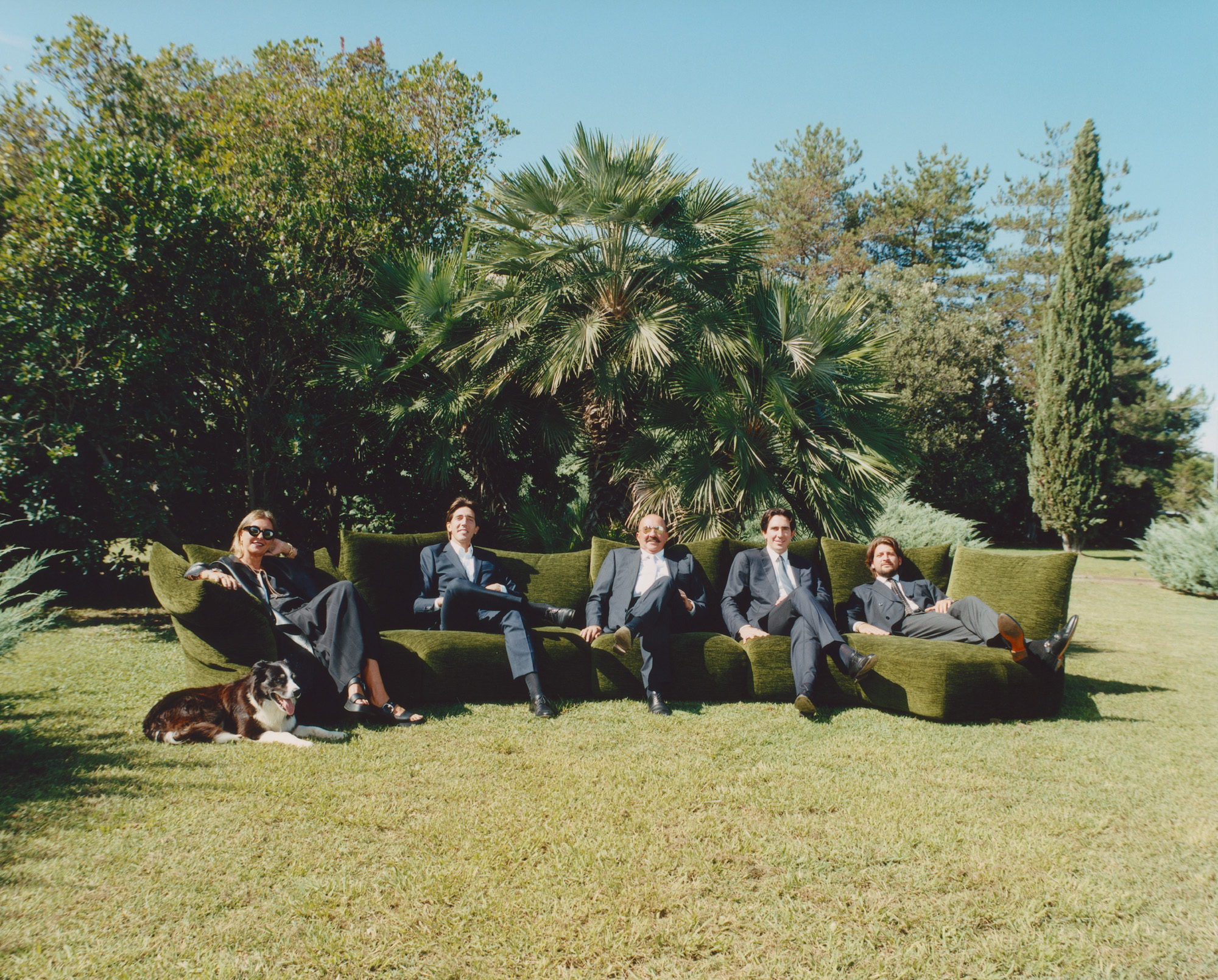
Monica, Niccolò, Valerio and Edoardo Mazzei and Umberto Manetti (with Blu) photographed at the Edra headquarters in Perignano with the brand’s ‘Standard’ sofa, designed by Francesco Binfaré
Growing up in the Tuscan countryside, Edra vice president Monica Mazzei’s childhood home doubled as a furniture showroom, where her mother would welcome customers as if they were guests. In 1987, Mazzei and her brother Valerio continued their family legacy when they founded Edra (the name references the Greek and Roman exedra, a space with seating for meeting and conversation) in the Tuscan town of Perignano. Known for its innovative upholstery techniques, avant-garde designs and dedication to artisan production, Edra now boasts a global presence, furnishing luxury homes, hotels and public spaces worldwide.
Meet the family: Valerio Mazzei, president; Monica Mazzei, vice president; Niccolò Mazzei, director of international development; Edoardo Mazzei, operations manager; Umberto Manetti, Lombardy sales manager
Wallpaper*: How has Edra differentiated itself in the landscape of Italian design?
Monica Mazzei: The word ‘design’ does not belong to us. Our model is more that of the art workshop, as happened in Florence at the time of the Medicis. We have remained true to the values of the Renaissance, trying to combine innovation and the most advanced technology with craftsmanship.
W*: Why have you decided to stay independent and not accept outside investment? Has there ever been a time that it’s been tempting?
MM: We were born like this, into a family where home and work have always been the same thing. There have been many requests, but at the moment, we are not interested.
Wallpaper* Newsletter
Receive our daily digest of inspiration, escapism and design stories from around the world direct to your inbox.
W*: What is so special about the Italian family business model?
MM: We are a company that has chosen to work with the territory and on product quality. Some collaborators started with us and then passed the baton on to their children and their grandchildren. That is a beautiful thing, it gives us joy. Sometimes
we are told that Edra is like a big family, and this is truly a great satisfaction for us.
W*: Do you have plans in place for the next generation to take over one day, and if so, what are they?
MM: We would be delighted if the company passes from generation to generation. No one has ever been forced to take a position and, in my opinion, it shouldn’t be an obligation. For the children, it was a free choice and they too must find the pleasure of carrying forward this commitment. There must be the ability to do one’s job well and think that one does it not only for oneself.
W*: What is the longest-serving piece in the Edra catalogue?
MM: The ‘Tatlin’ sofa, designed by Mario Cananzi and Roberto Semprini, which has been in the Edra portfolio since 1989.
Dedar
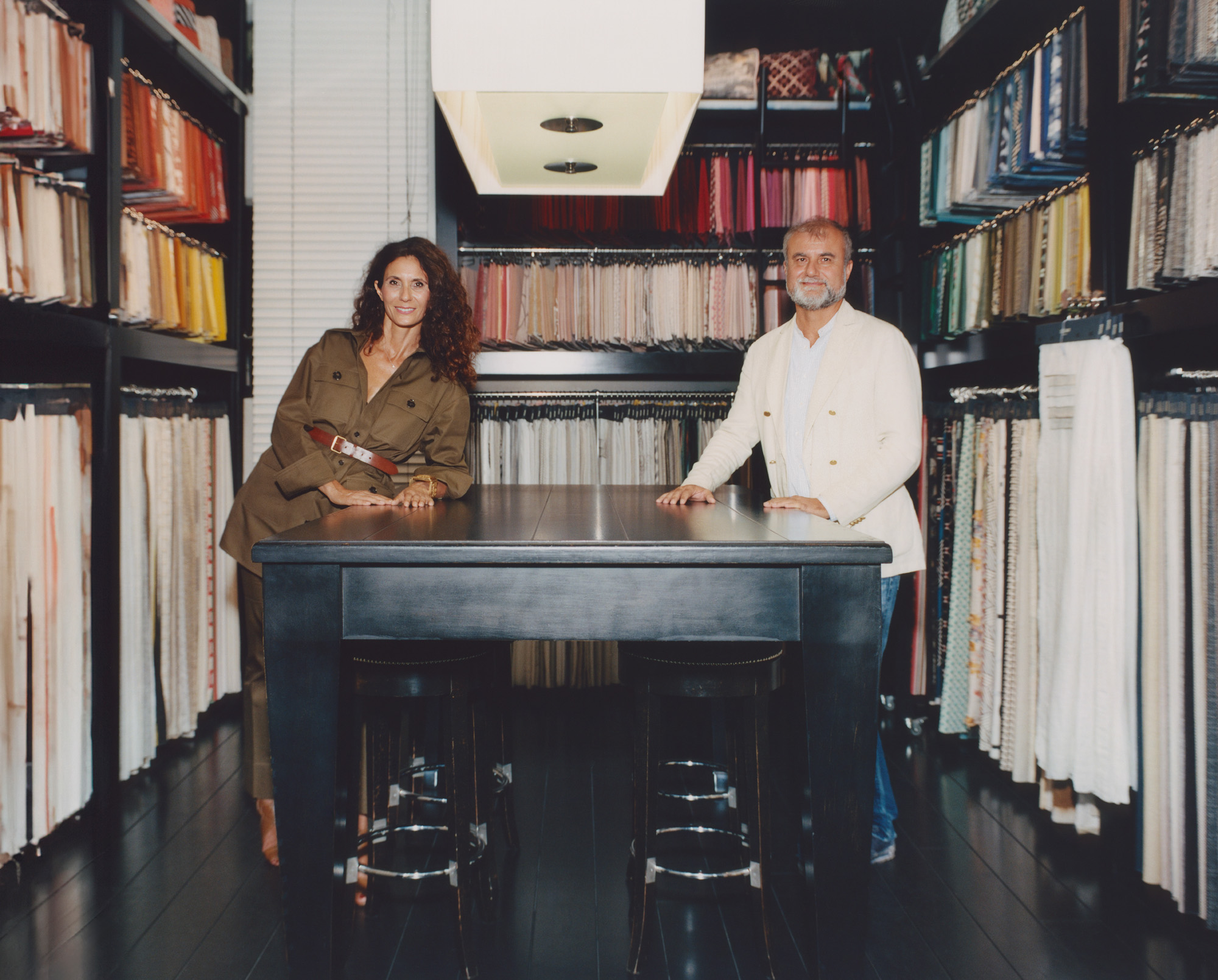
Caterina and Raffaele Fabrizio photographed at the Dedar showroom in Milan surrounded by fabrics
When Nicola and Elda Fabrizio founded Dedar in Como in 1976, it was a small artisanal fabric house producing curtains and wallcoverings. Since 1997, the second generation, siblings Caterina and Raffaele Fabrizio, have been in charge, and the company now has dedicated showrooms in Milan, London and Paris. Recent partnerships with the likes of Hermès, as well as the brand’s ubiquitous presence in high-end hotels and luxury homes, have enshrined its place in the upper echelons of textile brands, while still retaining its artisan heritage.
Meet the family: Caterina Fabrizio, co-owner and CEO; Raffaele Fabrizio, co-owner and creative director
Wallpaper*: What are your earliest memories of the company?
Raffaele Fabrizio: I feel like I joined the company when I was born. My first memories are travelling to Anatolia or India with our parents to search for rugs because at the time their passion was rugs and carpets. I was able to see how textiles could create emotions.
W*: What were some of the company’s early decisions that led to its long-term success?
RF: When my parents started the company, fabrics like silk taffeta symbolised beauty and tradition in a bourgeois home. But over time, families didn’t have the time or will to take care of them with the delicacy they required. They understood that by adding synthetic yarn in a way that was just as beautiful, the fabric could be functional and easily washable. They could really see what the market wanted at that moment.
Caterina Fabrizio: Our mother was always very contemporary. She was one of the first people to own a Prada purse in nylon. She understood that something could be functional and chic at the same time.
W*: What does research involve for Dedar?
RF: For us, it’s important that a fabric tells a story. ‘Magnolia’, for example, is inspired by the early monochrome paintings of Piet Mondrian. I saw an exhibition of his work and was fascinated by it.
W*: What is one of the greatest challenges for a family company?
CF: You have to follow your instincts, but also listen to those around you. It’s easy to find people who will always tell you ‘yes’. It’s harder to accept people that challenge you, but it’s so important.
W*: What does a big family meal look like?
CF: Our mother loves to make the most beautiful tablesettings. She collects fabrics so she has a huge number of tablecloths. She puts out exquisite glassware, flowers and little presents for every person. There’s always an element of surprise.
RF: Our father passed away a few years ago, but he had a passion for cooking. He loved making different types of pasta. He would always add a secret ingredient and have us guess what it was.
W*: What is the longest-serving design in the Dedar catalogue?
RF: The ‘Amoir Libre’ fabric, launched in 2013.
Flexform
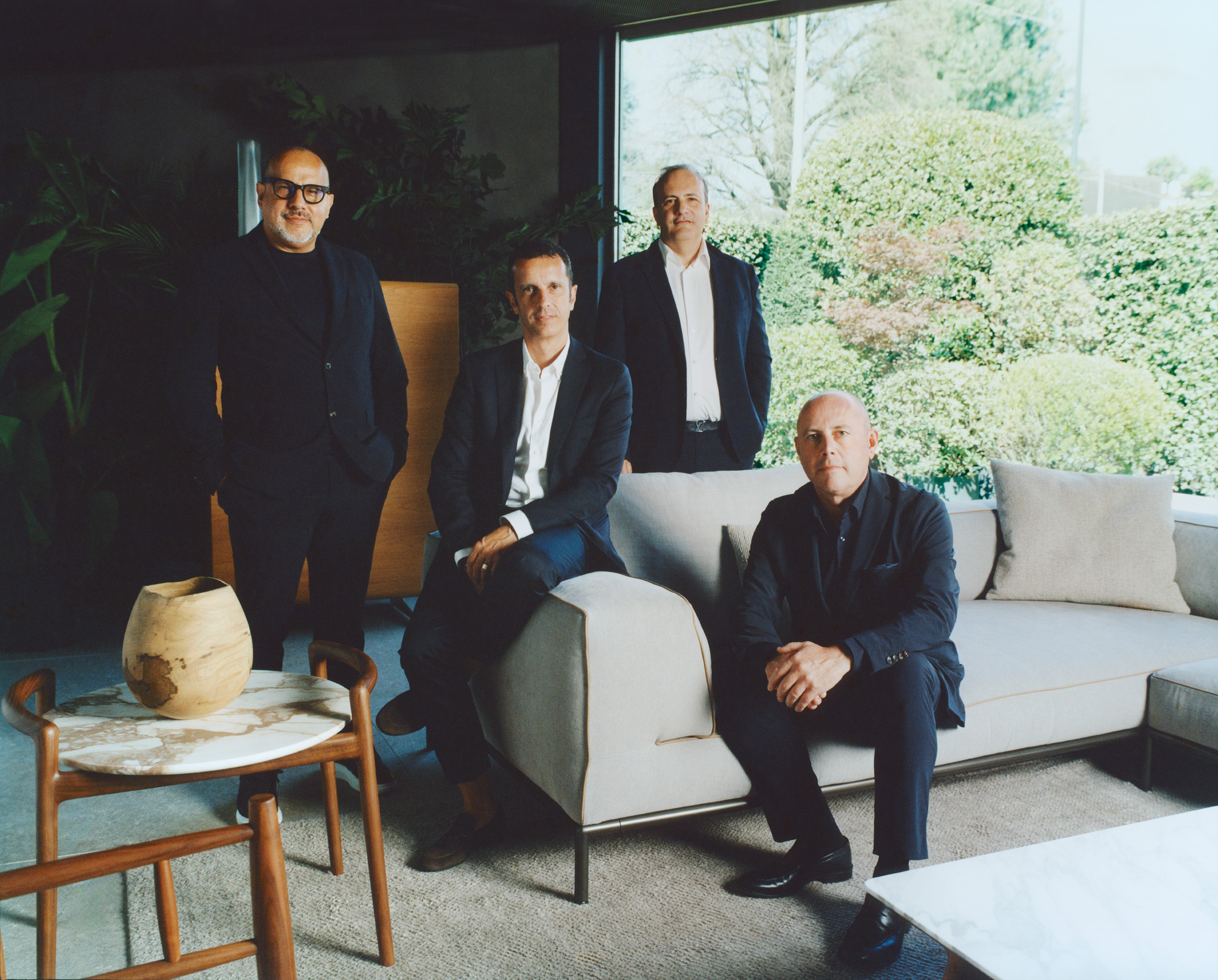
Saul, Matteo, Luca and Giuliano Galimberti photographed at the Flexform showroom in Meda with the brand’s ‘Ascanio’ side table and ‘Perry Up’ sofa, both designed by Antonio Citterio
When Flexform was founded in Brianza in 1959, the company was among the first in what would be an explosion of design brands originating from the Lombardian region. What began as a small artisan workshop, run by brothers Romeo, Pietro and Agostino Galimberti, has evolved intoan international design powerhouse, best known for its elegantly and impeccably crafted sofas. Now under the direction of the third generation, cousins Giuliano, Saul, Matteo and Luca, it boasts flagship stores on six continents.
Meet the family: Pietro Galimberti (not pictured), president; Giuliano Galimberti, export sales director; Saul Galimberti, design R&D director; Matteo Galimberti, Italy sales director; Luca Galimberti, logistics director
Wallpaper*: Why did you decide to join the family company?
Giuliano Galimberti: As a child, I had no clue about design and beautiful furniture, although I spent a lot of time in the factory with my father. It was only later on, when, at 23, I started working for the company that I became fully aware of the uniqueness of our designs. There was never any pressure to be involved in the business. I did it in total freedom and with great enthusiasm.
W*: The second generation of the family developed Flexform from a small artisanal workshop to an industrial operation. What new ideas were introduced by the third generation?
GG: The second generation drew lines that remain embedded in our identity, but the third made it possible to generate interest and to make it, above all, available on a global scale.
W*: Why have you decided to stay independent and not accept outside investment?
GG: Ours is a family business and I feel proud to work here alongside my cousins. Now and then, there are differing opinions about how we should handle some issues, but the ‘we attitude’ leads us towards the decision that is best for the company. Thinking in collective terms is the key to remaining an independent family business in the design field, particularly in Italy, where many historical brands have been incorporated into international holdings.
W*: In your opinion, what is the key to longevity?
GG: The love for the project. The company is viewed as a fundamental element of our family and not just a business to be managed.
W*: What does a big family meal look like?
GG: Loud and messy – but always fun.
W*: What is the longest-serving piece in the Flexform catalogue?
GG: Our ‘Magister’ sofa, designed by Antonio Citterio in 1982. Its understated, minimal aesthetic demonstrates our ability to produce furnishings that marry an aptitude for innovation with years of experience in traditional upholstering.
Kartell
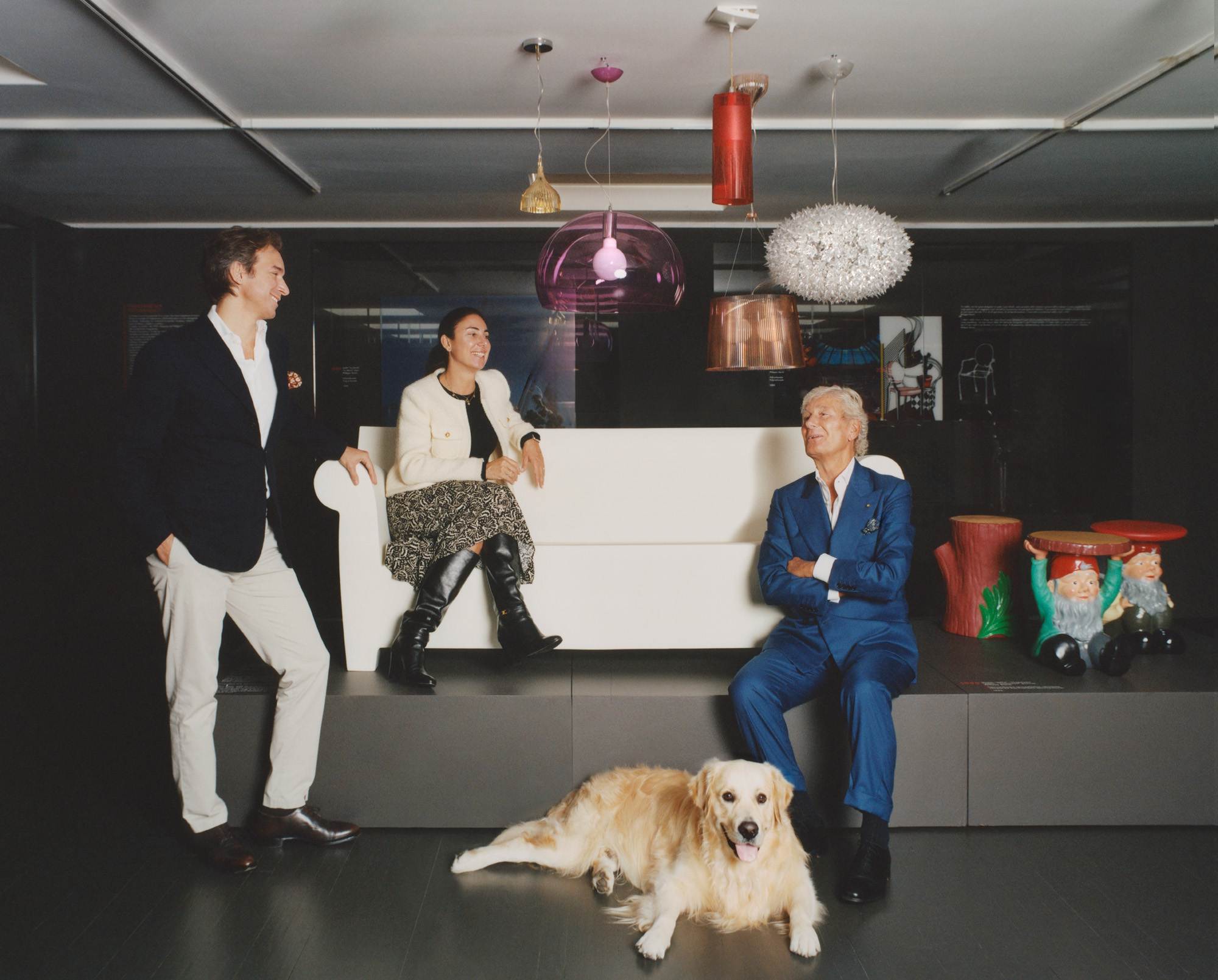
Federico, Lorenza and Claudio Luti (with golden retriever Jack) photographed at the Kartell Museum in Noviglio with the brand’s ‘Bubble Club’ sofa and ‘Saint Esprit’ and ‘Attila’ side tables, all designed by Philippe Starck, and ‘È’, ‘Fl/y’, ‘Easy’, ‘Gè’ and ‘Bloom’ pendants, all designed by Ferruccio Laviani
Kartell was founded by Giulio Castelli in 1949 with the vision of creating domestic goods and furniture from plastic, then a fairly novel material, and it has been based in Noviglio, in Milan, since 1967. In 1988, Castelli’s son-in-law, Claudio Luti, fresh from a decade as the managing director of Versace, purchased the brand and set it on a trajectory to become a household name. A focus on material experimentation, and collaborations with designers such as Philippe Starck, Ron Arad, Patricia Urquiola and Ferruccio Laviani, have brought global success: the brand now operates 150 flagship stores across the globe.
Meet the family: Claudio Luti, president; Lorenza Luti, marketing and retail director; Federico Luti, worldwide commercial director
Wallpaper*: Why did you decide to join the family company?
Lorenza Luti: My brother Federico and I both studied economics, so it was quite natural that we would eventually join the company. During university, we would work at the Salone del Mobile booth – but, of course, when we had smaller roles, it was more just party time. Both of us worked for a few years in other companies before arriving at Kartell. I worked at Zegna. It was there that Anna Zegna [president of Fondazione Zegna] advised me that I would learn more quickly if I joined our family company as soon as possible. So I came to Kartell immediately.
W*: One of the key aspects of Kartell’s success is the portfolio of incredible designers that you have collaborated with over the years. How do you choose who you want to collaborate with, and what do you look for?
Claudio Luti: When I find designers for Kartell, I have to respect the brand’s identity, but I want to create an iconic piece every time. We look to offer our customers variety, using different materials, different creativities and a different philosophy. But most of all, we look for an attention to quality.
W*: Looking back at the past several decades, can you pinpoint a few moments that you think shaped Kartell’s success and longevity?
CL: I arrived in 1988 and my first idea was to ensure we maintained industrial production with a lot of creativity and superior quality.
W*: Are there any lessons from previous generations that you apply to your work today?
Federico Luti: From my grandfather, the spirit of innovation. From my grandmother, hard work.
W*: Do you think it is still possible to create multi-generational companies in Italy?
FL: In Italy, it’s a matter of culture, a way of living. Family is important, so I think there will always be family businesses, and not only in our market.
W*: What is the longest-serving piece in the Kartell catalogue?
LL: The ‘Componibili’ cabinet, designed by our grandmother Anna Castelli Ferrieri in 1967.
Living Divani
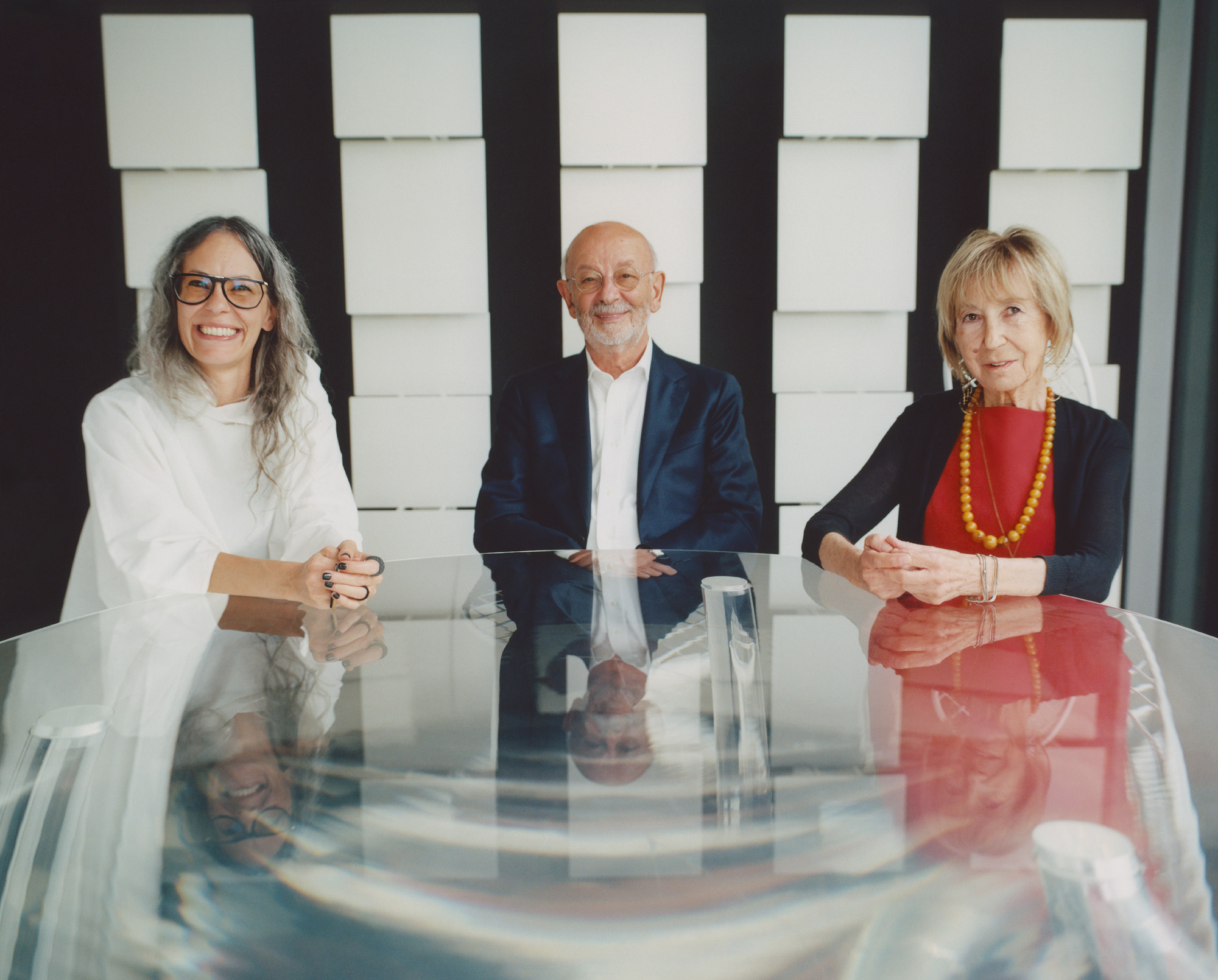
Carola and Luigi Bestetti and Renata Pozzoli photographed at the Living Divani headquarters in Anzano del Parco with the brand’s ‘Drop’ table, designed by Junya Ishigami
Founded in 1969 in Anzano del Parco, in Brianza, by Renata Pozzoli and Luigi Bestetti, Living Divani has since garnered a reputation for its elegant and minimalist contemporary aesthetic, much of it thanks to the brand’s longstanding collaboration with architect Piero Lissoni, who has been art director since 1988. Their daughter, Carola Bestetti, now leads the company, having joined in 2003, expanding the brand’s international reach and securing collaborations with the industry’s top designers, such as David Lopez Quincoces, Marco Lavit, Shibuleru, Mist-o, Lanzavecchia +Wai.
Meet the family: Renata Pozzoli, founder and president; Luigi Bestetti, co-founder; Carola Bestetti, CEO
Wallpaper*: What are your earliest memories of the company?
Carola Bestetti: My parents devoted most of their lives to creating this business; we grew up with the company. My first real memory was visiting the factory and rollerskating across the concrete floor. We used to have our birthdays at the headquarters. We had big spaces and gardens, so we used to throw our parties there.
W*: The collaboration with Piero Lissoni has been an important part of Living Divani’s story. How did involving him as an art director help to shape the company?
CB: I always say that Piero is the person that gave shape to the idea of the company my parents had. I think that is why this collaboration has been so fruitful for such a long time. In the past 35 years, we’ve come out with products that, sometimes, were too ahead of their time and subsequently, the endurance of those pieces has been very long. Some pieces that were designed back in the 1990s still feel contemporary today. That timelessness has been the key to our successful collaboration.
W*: How would you like to see the company grow?
CB: My goal is to consolidate what we have and expand towards new markets, such as India and parts of Africa, where there is a lot happening in terms of hospitality. The phase that we’re in right now is restructuring the company to do that properly.
W*: In your opinion, what is so special about the Italian family business model?
CB: It used to be that someone with a specific skill like furniture-making would develop it at home, which is what led to the casa bottega [home workshop] model. Expertise was handed down from generation to generation, with the entire family living and working in the same space. Eventually, those family businesses evolved into industries, which is what happened in Brianza, where the Italian furniture industry is based.
W*: What is the longest-serving piece in the Living Divani catalogue?
CB: The ‘Frog’ chair, designed by Piero Lissoni in 1995. Next year will be its 30th anniversary and we plan to release an updated version to celebrate.
Minotti
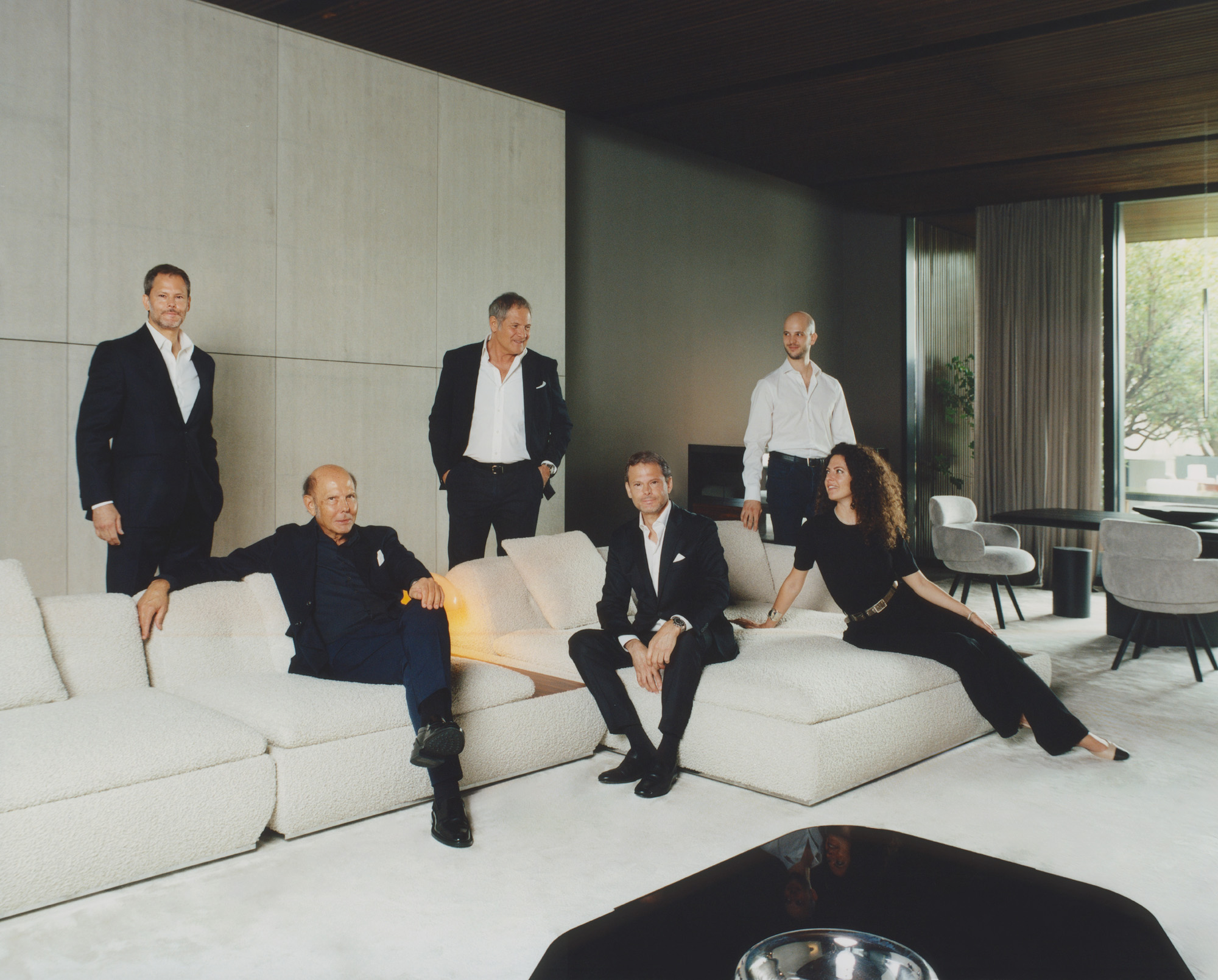
Alessio, Renato, Roberto, Alessandro, Leonardo and Susanna Minotti photographed at the Minotti headquarters in Meda with the brand’s ‘Supermoon’ sofa, designed by Giampiero Tagliaferri, ‘Vivienne’ dining chairs, designed by GamFratesi, and ‘Nico’ dining table, designed by Hannes Peer
When Alberto Minotti opened his namesake furniture company in 1948 in Meda, near Milan, it was a simple artisan workshop. Over the following decades, the brand expanded rapidly: by the time current co-CEOs, brothers Renato and Roberto Minotti, took over in 1991, Minotti was trading internationally with a reputation for finely crafted Italian upholstery. The brand now has a presence in 80 countries worldwide.
Meet the family: Roberto Minotti, co-CEO; Renato Minotti, co-CEO; Alessio Minotti, R&D manager/head of purchasing; Alessandro Minotti, general manager/head of international sales network; Susanna Minotti, head of interior decoration; Leonardo Minotti, product engineering department
Wallpaper*: Did you ever feel any pressure to join the family company?
Roberto Minotti: Ever since I was a child, I have always had a special connection with our family business. I often used to visit the company, which is located in front of our family home. It is a place that holds many memories of my father. I used to see him passionately making decisions, developing new designs, and working alongside younger collaborators to pass on different upholstering techniques. He was a creative personality who always inspired me and who, years later, encouraged me to study architecture.
W*: In the 1980s and 1990s, what were the steps needed to grow Minotti from a brand only sold in Italy to one sold internationally?
Roberto: In the mid-1980s, Minotti had both a classic soul and a more contemporary one. We decided to move decisively towards the contemporary style, expanding the product range from seating to furnishing accessories while preserving high-quality craftsmanship. We also introduced the slogan ‘Classics Today, Classics Tomorrow’.
W*: What does research and development look like for a historic brand like Minotti?
Renato Minotti: Our approach is always focused on sophisticated craftsmanship, attention to detail, precision and continuous research, keeping faith with our intention to realise handmade products to achieve the highest quality without completely losing ground to industrialisation. Modern technology, on the one hand, and attention to tailoring, on the other, have made our style recognisable all over the world.
W*: Do you think the brand will ever decide to sell?
Renato: Minotti has always been a family-owned company and will remain so. We all work passionately to carry on the brand’s development together and deal with upcoming challenges. During moments of significant transformations, we keep the company spirit alive, supported by our strong family union.
W*: What is the longest-serving piece in the Minotti catalogue?
Roberto: The ‘Cesar’ coffee table, the ‘Van Dyck’ table and the ‘Hamilton’ sofa, all designed in 2004 by Rodolfo Dordoni.
Molteni
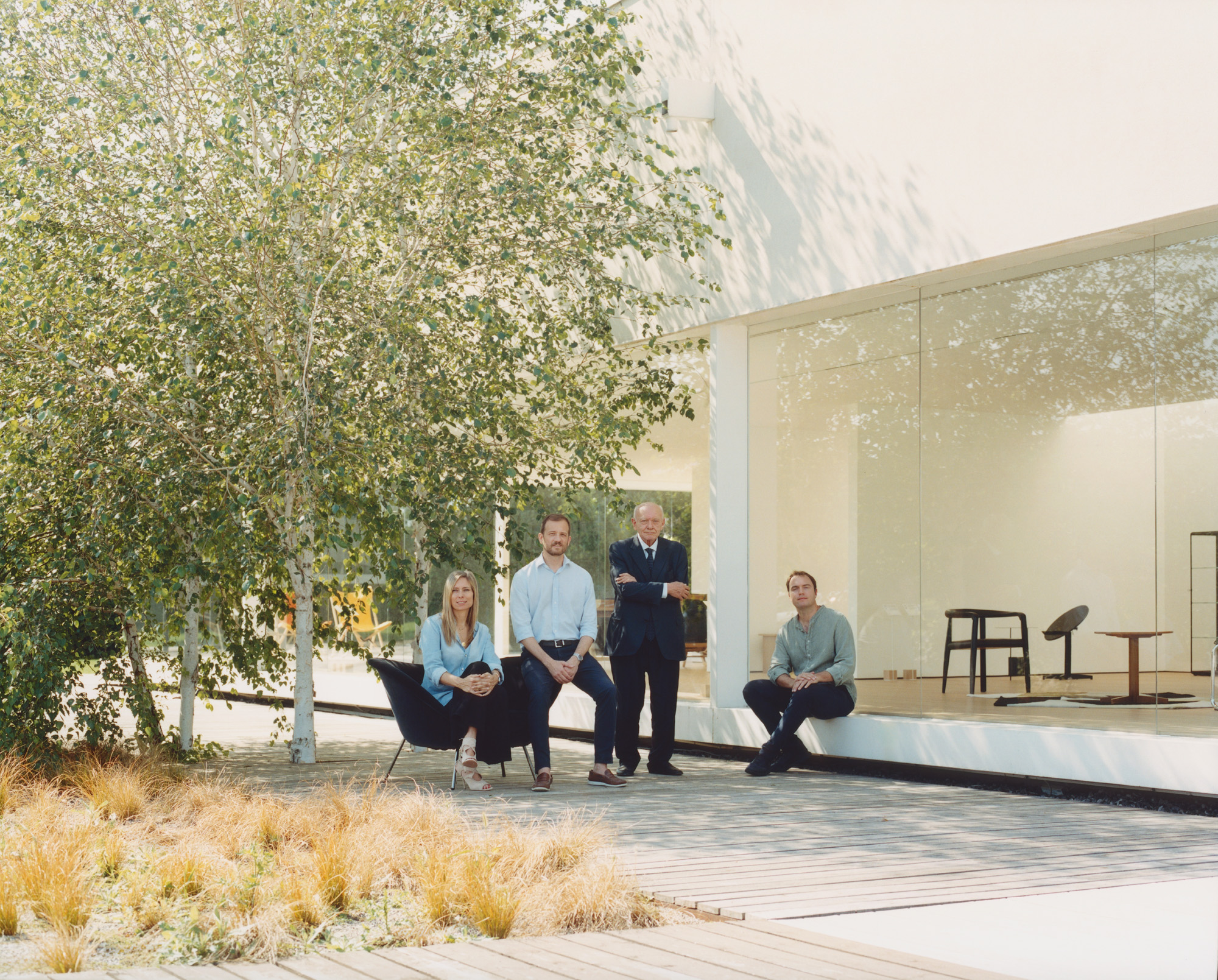
Giulia, Andrea, Carlo and Giovanni Molteni photographed at the Molteni Museum in Giussano with the brand’s ‘D.154.2’ chair, designed by Gio Ponti, and ‘Miss’ chair, designed by Afra and Tobia Scarpa
Molteni & C has operated from the Lombardian village of Giussano for more than 90 years. Founded by Angelo Molteni in 1934, for the past nine decades, it has been an industry leader: as one of the founding exhibitors at the Salone del Mobile; by working with a host of high-profile collaborators, including Norman Foster and Herzog & de Meuron; and by cleverly diversifying its portfolio into sister companies, kitchen brand Dada and office outfitter UniFor.
Meet the family: Carlo Molteni, CEO and president; Giulia Molteni, CMO; Giovanni Molteni, vice president; Andrea Molteni, vice president; Carlo Molteni, CEO of UniFor; Pietro Molteni, CFO of UniFor; Angelo Molteni, CEO of Asia Pacific UniFor
Wallpaper*: What are your earliest memories of the company?
Giulia Molteni: One of the strongest is the first time I met [longtime Molteni collaborator] Jean Nouvel in our Paris flagship store. He is probably the most genius person I have ever known, and I remember being so moved by his clarity and humble manner when speaking to me about architecture. He must have immediately understood that I was young and totally inexpert, but it didn’t keep him from sharing a bit of himself with me. I’ll never forget it.
W*: What kind of lessons did you learn from your relatives who worked at Molteni before you?
GM: I have shared the privilege of growing up within a large family, and a large company, with my brother and cousins, and with my father, who set a great example. What he conveyed to me is a respect for the work, and the ability to listen, which is fundamental. He also taught me the passion for what we do, and
an acute vision of work and family dynamics.
W*: Why did you eventually decide to join the family company?
GM: After graduating in economics and business from Bocconi University in 2003, I started at Loro Piana in New York as a retail manager. During my university years, I had perceived the beauty of the design industry, but, at that moment, I needed to distance myself, to go abroad. I was only supposed to be in the US for six months, but it turned into four years. Then something changed inside me. I knew that I would have the opportunity to do many more things in my company rather than elsewhere. The experience abroad was formative, but perhaps my father’s teachings were more so.
W*: What new markets is Molteni looking to expand into?
GM: We are looking at new emerging markets like Saudi Arabia and India.
W*: What is the longest-serving piece in the Molteni catalogue?
GM: The ‘505’ modular shelving system, designed by Luca Meda in 1972, and ‘Carteggio’, the secretaire designed in 1987 by Aldo Rossi.
Porro
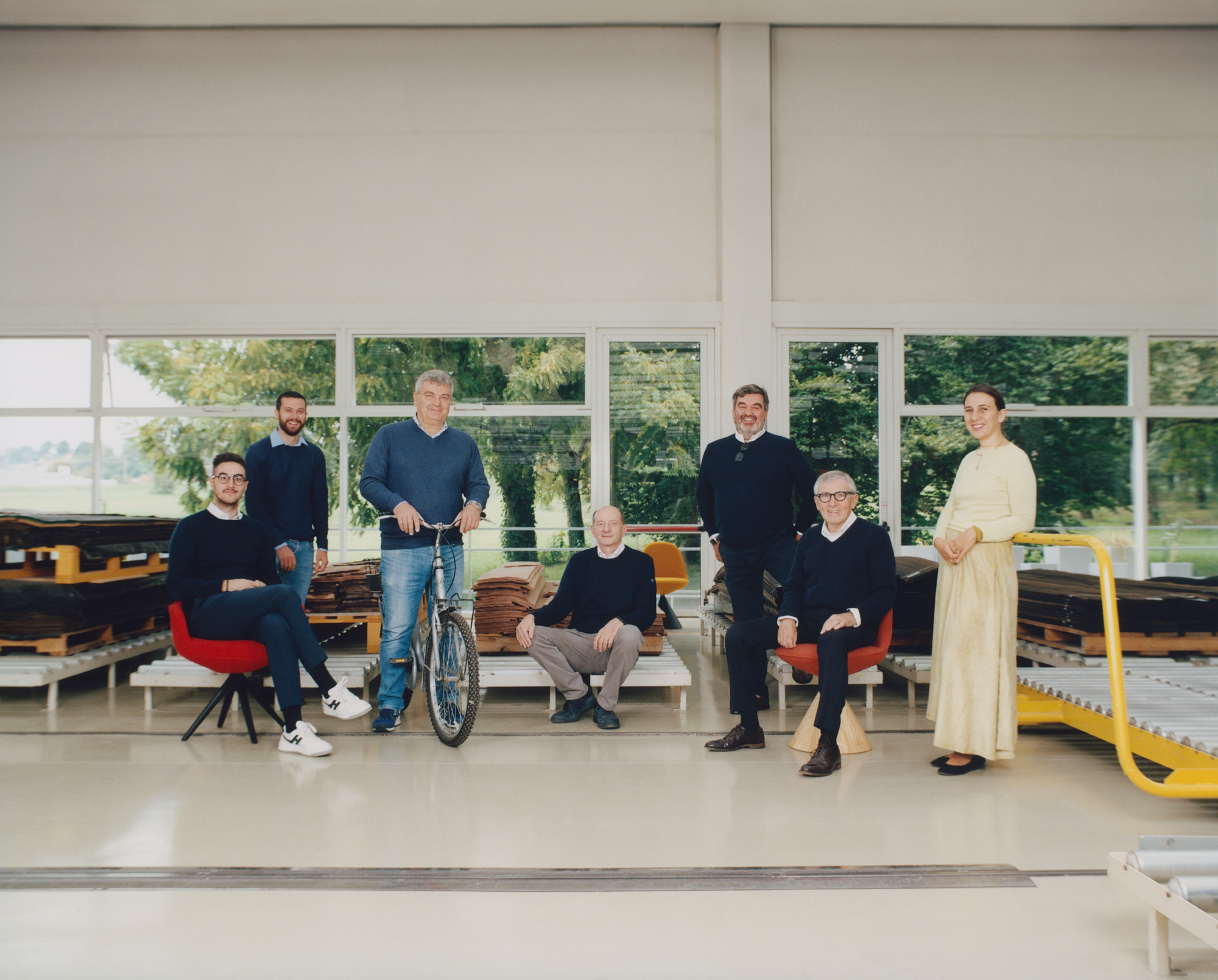
Giulio, Giovanni, Giovanni, Danilo, Fabio, Lorenzo and Maria Porro photographed at the Porro headquarters in Montesolaro with the brand’s ‘Romby’ chairs, designed by GamFratesi
As one of the oldest Italian design brands still in operation, Porro, founded in Montesolaro, in Brianza, in 1925, forms the backbone of the Italian design industry – not only for its longevity, but also its current head of marketing and communication, Maria Porro (daughter of company president Lorenzo), who has been president of the Salone del Mobile since 2020. Known for its innovative modular storage systems and impeccably constructed household furniture, Porro’s global network of showrooms and monobrand stores stretches across five continents.
Meet the family: Lorenzo Porro, president; Danilo Porro, CED manager; Fabio Porro, contract division and procurement manager; Giovanni Porro, production manager; Maria Porro, head of marketing and communication; Giovanni Porro, quality and management system co-ordinator; Giulio Porro, procurement specialist
Wallpaper*: You worked as a set, costume and production designer before joining Porro. How did you initially define your role?
Maria Porro: I was always involved in the Salone del Mobile preparation. I created Material House, a special collection that we did with Piero Lissoni. Even though I had a unique experience because of my background, when I officially joined the company, I dedicated my time to understanding it. I worked shoulder-to-shoulder with my father looking after international distribution, but the most natural path was marketing and communication, which for me, is more about the strategic vision of the company.
W*: How do you navigate generational differences?
MP: I think every generation has a crucial moment when the new generation has a different answer to the older one. And sometimes, the new generation is right. My grandfather founded the company as an artisan workshop, but my father studied architecture at Milan’s Politecnico University. He was starting to think about modular bookshelves and new ways of production. My grandfather was initially against it, but my father insisted, and they have become an essential part of our catalogue. It was the same when I wanted to open monobrand stores – my father said no, but because of our strong identity, it was a success.
W*: In addition to your role at Porro, you are also the Salone del Mobile president. In your opinion, what has the Salone’s role been in shaping the Italian design industry?
MP: Salone has always been very important for the Italian design community. There’s a lot of competition, but it’s why so many brands have evolved: it forces
you to build an identity. I think that competing together can reinforce individual brands, turning competition into co-operation.
W*: What is the longest-serving piece in the Porro catalogue?
MP: The modular ‘System’ shelving units, designed by Piero Lissoni in 1996.
This article appears in the December 2024 issue of Wallpaper*, available in print on newsstands from 7 of November, on the Wallpaper* app on Apple iOS, and to subscribers of Apple News +. Subscribe to Wallpaper* today
Laura May Todd, Wallpaper's Milan Editor, based in the city, is a Canadian-born journalist covering design, architecture and style. She regularly contributes to a range of international publications, including T: The New York Times Style Magazine, Architectural Digest, Elle Decor, Azure and Sight Unseen, and is about to publish a book on Italian interiors.
-
 Put these emerging artists on your radar
Put these emerging artists on your radarThis crop of six new talents is poised to shake up the art world. Get to know them now
By Tianna Williams
-
 Dining at Pyrá feels like a Mediterranean kiss on both cheeks
Dining at Pyrá feels like a Mediterranean kiss on both cheeksDesigned by House of Dré, this Lonsdale Road addition dishes up an enticing fusion of Greek and Spanish cooking
By Sofia de la Cruz
-
 Creased, crumpled: S/S 2025 menswear is about clothes that have ‘lived a life’
Creased, crumpled: S/S 2025 menswear is about clothes that have ‘lived a life’The S/S 2025 menswear collections see designers embrace the creased and the crumpled, conjuring a mood of laidback languor that ran through the season – captured here by photographer Steve Harnacke and stylist Nicola Neri for Wallpaper*
By Jack Moss
-
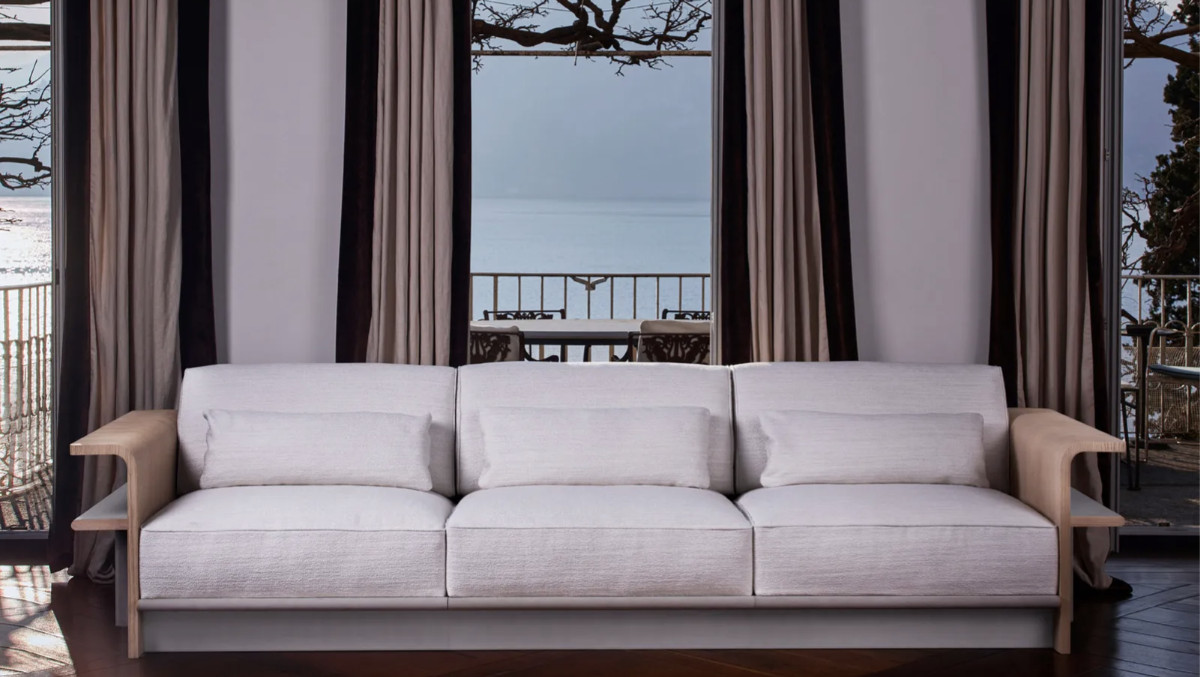 Promemoria’s new furniture takes you from London to Lake Como, with love
Promemoria’s new furniture takes you from London to Lake Como, with loveAhead of its Milan Design Week 2025 debut, we try out Promemoria’s new furniture collection by David Collins Studio, at founder Romeo Sozzi’s Lake Como villa
By Laura May Todd
-
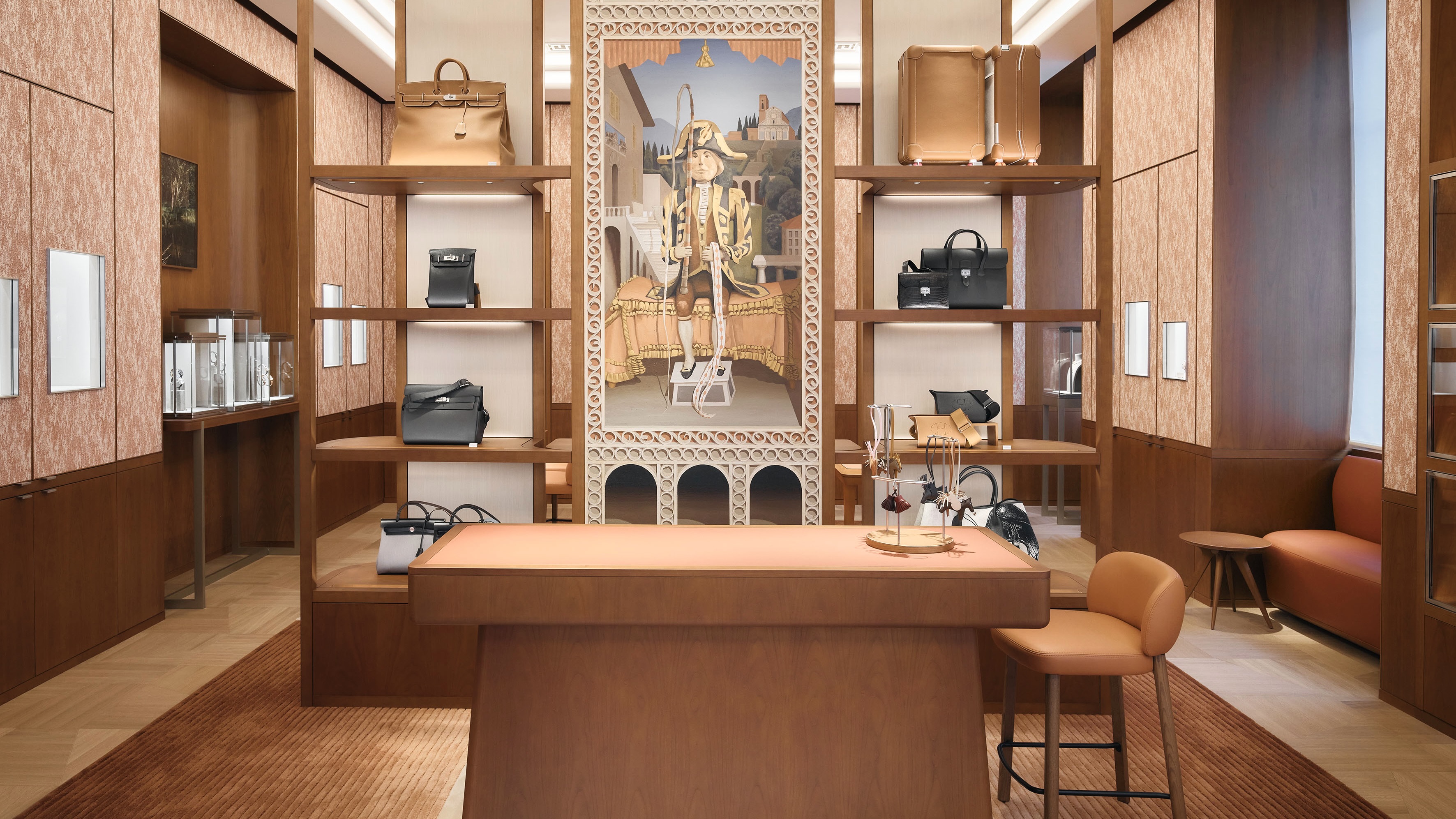 Hermès’ new Florence store is a haven of sophisticated design
Hermès’ new Florence store is a haven of sophisticated designThe Renaissance building on Via degli Strozzi boasts interiors by architect Denis Montel of RDAI, bespoke furniture pieces and an expansive collection of artwork
By Nick Vinson
-
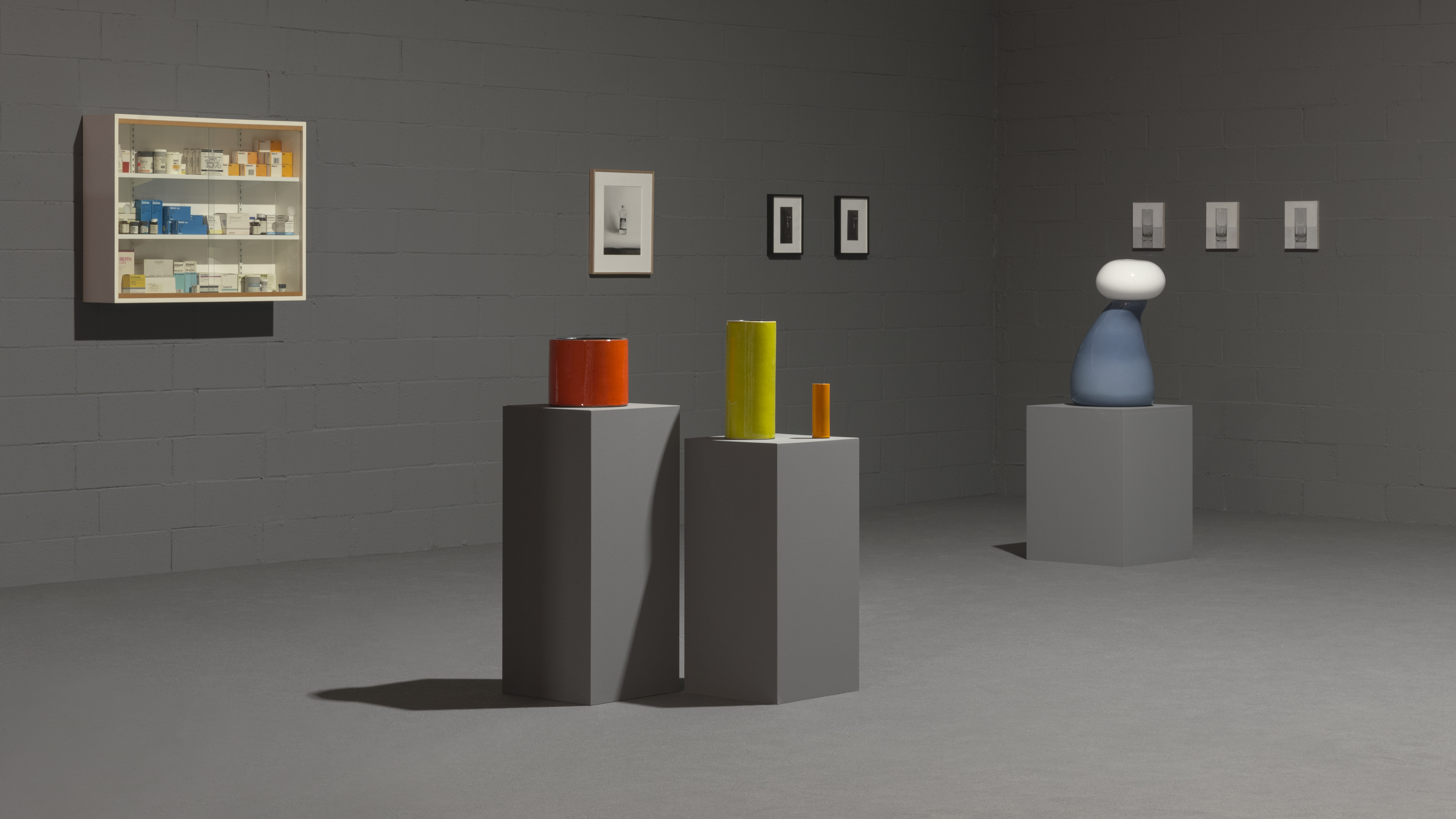 Ceramics brand Mutina stages a poetic tribute to everyday objects
Ceramics brand Mutina stages a poetic tribute to everyday objectsDesign meets art as a new Mutina exhibition in Italy reframes the beauty of domestic stillness, juxtaposing ceramics, sculpture, paintings and photography
By Laura May Todd
-
 Rooms with a view: a new book celebrates the Italian approach to interior design
Rooms with a view: a new book celebrates the Italian approach to interior designLaura May Todd's survey of Italian interiors is the perfect antidote to January gloom, taking a look inside 50 distinctive Italian homes
By Ali Morris
-
 The future of Salone del Mobile: new report quantifies impact of the world's biggest furniture fair
The future of Salone del Mobile: new report quantifies impact of the world's biggest furniture fairFor the first time, Salone del Mobile reports on its size and impact. ‘Milan Design (Eco) System’ puts Salone into numbers, allowing its future and challenges to be addressed
By Cristina Kiran Piotti
-
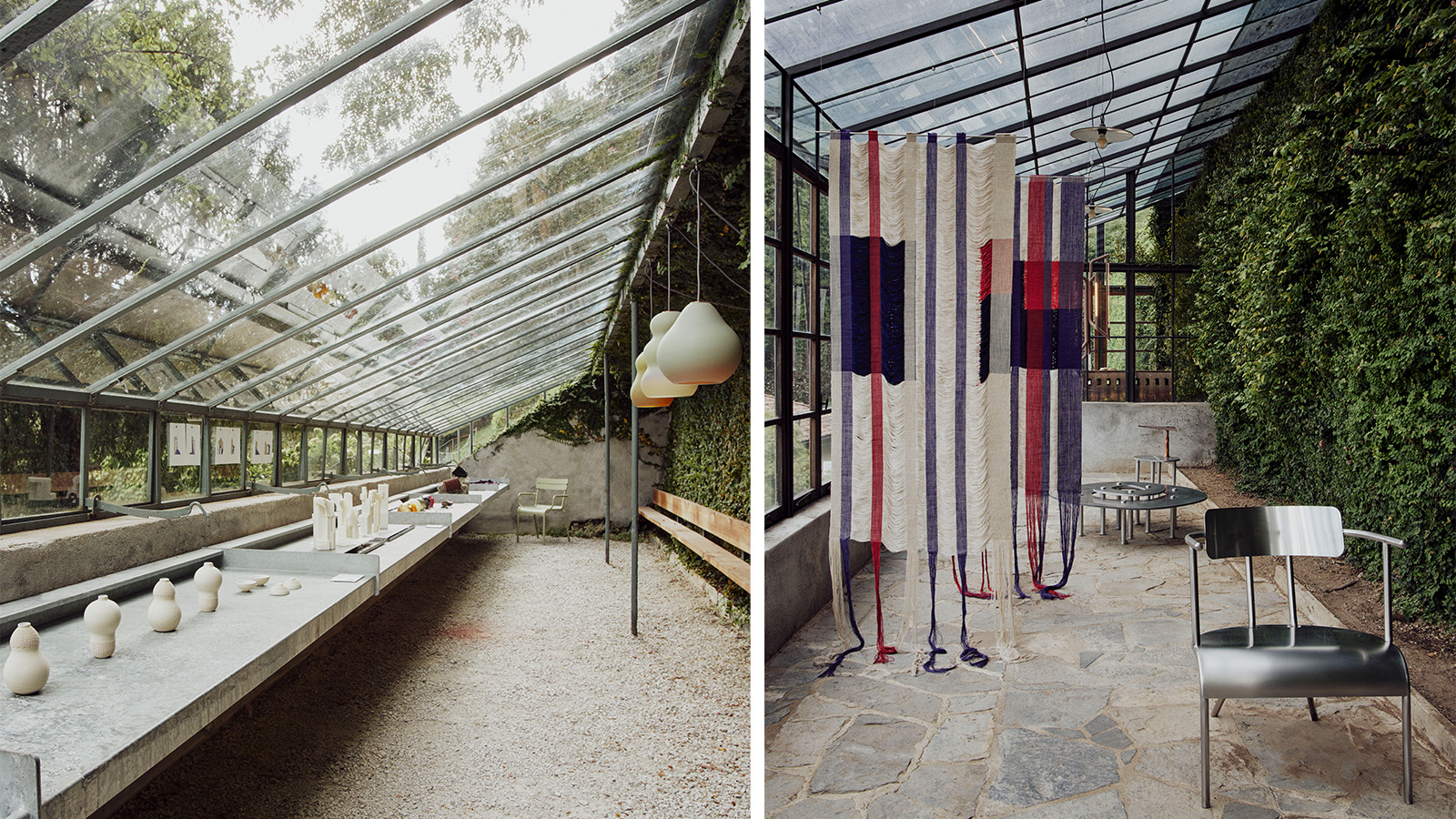 Designers make light work at Lake Como Design Festival 2024, revisiting heritage traditions
Designers make light work at Lake Como Design Festival 2024, revisiting heritage traditionsThe spectacular lakeside design festival, now in its sixth edition, occupied historic buildings and contemporary galleries with responses to the theme of ‘lightness’
By Ifeoluwa Adedeji
-
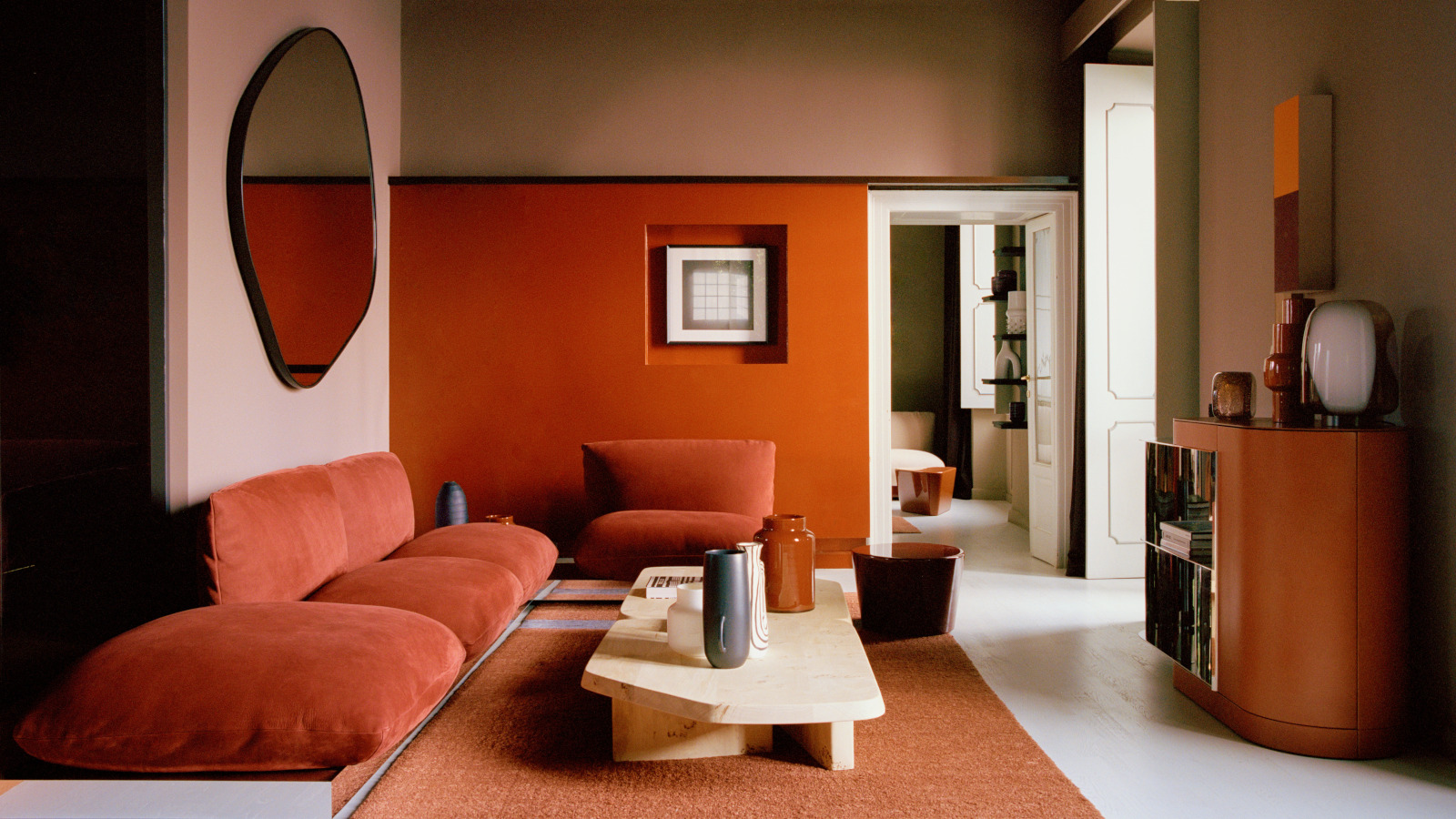 Baxter’s Lake Como retreat is ‘a home for design connoisseurs’
Baxter’s Lake Como retreat is ‘a home for design connoisseurs’Italian furniture brand Baxter showcases its 2024 collection at Casa sul Lago, a 20th-century Lake Como villa
By Simon Mills
-
 Alcova announces two historical locations for its 2024 edition
Alcova announces two historical locations for its 2024 editionPrepare to discover two iconic gems, as Alcova 2024 will take place at Villa Borsani and Villa Bagatti Valsecchi, just outside Milan (15 – 21 April 2024)
By Rosa Bertoli